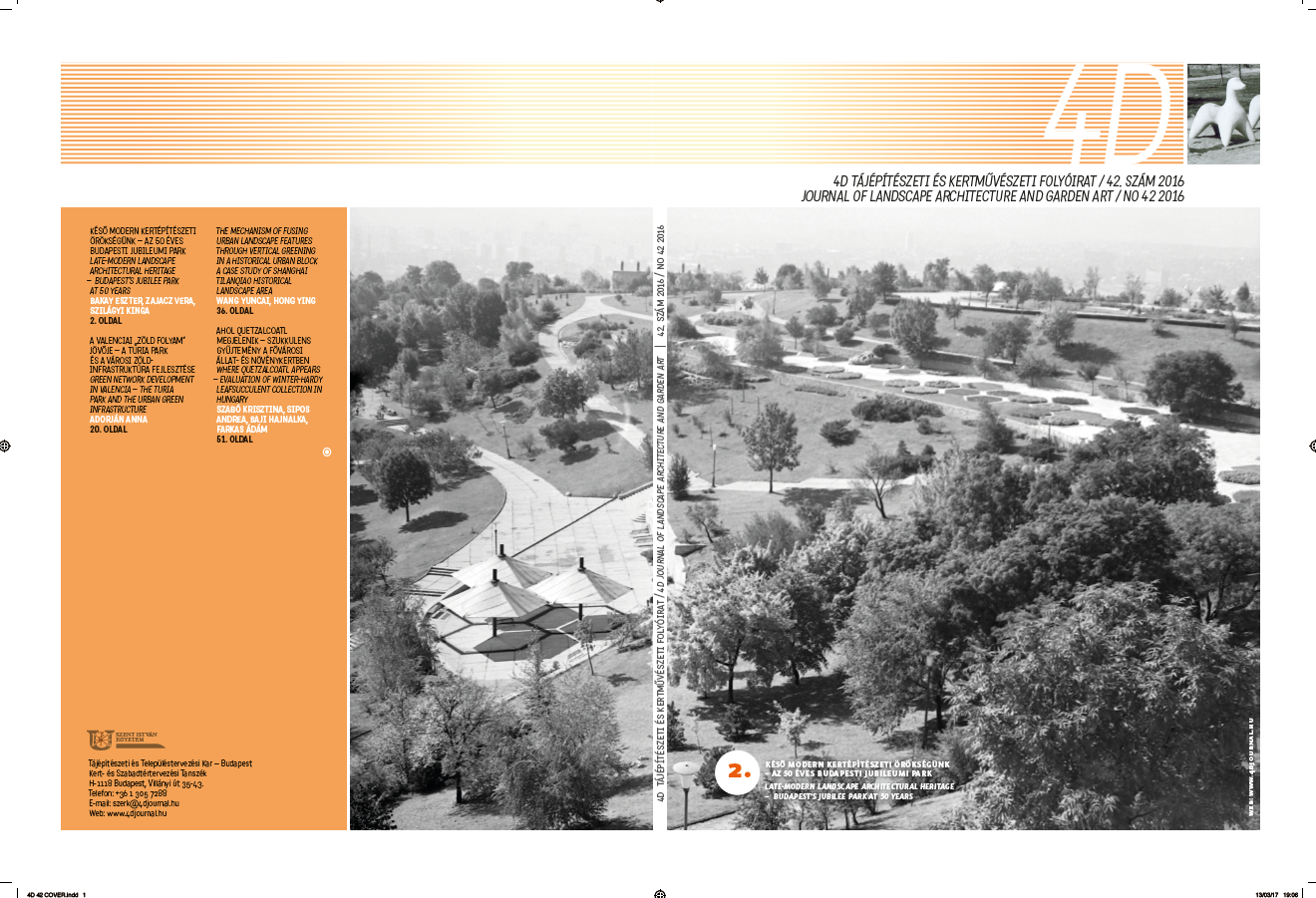The The mechanism of fusing urban landscape features through vertical greening in a historical urban block
a case study of shanghai tilanqiao historical landscape area
DOI:
https://doi.org/10.36249/4d.42.6044Keywords:
vertical greening, historical landscape area, urban regeneration, Shanghai Tilanqiao areaAbstract
Under the stress of high-density vertical cities, green spaces are also developing vertically. Despite the increasing usage of vertical greening in more and more Chinese cities, the focus of most cases is on the ecological effect of green façades in private buildings’ indoor environments. Only a few studies have examined the promotion of vertical greening with respect to the aesthetic quality of public spaces. This paper attempts to find an appropriate orientation to vitalize the universal value of vertical greening in public spaces based on its fusion with urban landscape features. Through the case study of vertical greening in historical blocks abroad, this paper explores the mechanism of fusing vertical greening with urban landscape features in historical blocks based on the classification and induction of context conflict when a regeneration process is carried out among buildings with different architectural styles in a historical landscape area. It also argues that this mechanism be adapted for the regeneration of
Shanghai Tilanqiao historical landscape area and proposes corresponding renovation strategies for vertical greening.
This paper suggests that 1) fusing urban landscape features in historical blocks is a good opportunity to popularize and apply vertical greening in today’s China and, in turn, 2) vertical greening is an effective design method for reconciling context conflicts in a historical landscape area, especially under the circumstance of conflict between an individual building and the surrounding context. In addition, in Tilanqiao historical landscape area, 3) the planning of vertical greening regeneration should be classified by taking the particular street conditions into account, and 4) the planning should be fulfilled in three periods based on the complexity, necessity and urgency of vertical greening regeneration projects.
References
Li Ronghua, Effects of Vertical Greening on Urban Beautification [J]. Journal of Green Science and Technology, 2011,03:20-21.
Ebtesam M. Elgizawy, The Effect of Green Facades in Landscape Ecology, Procedia Environmental Sciences, Volume 34, 2016, Pages 119-130
Irene Wong, Andrew N. Baldwin, Investigating the potential of applying vertical green walls to high-rise residential buildings for energy savingin sub-tropical region, Building and Environment, Volume 97, 15 February 2016, Pages 34-39
Yuan Bin, Wang Dawei, Analysis of Evaluation Standard of Green Building in China [J], Intelligent Building & City Information, 2007,04:14-18.
Antonio Maciá A&D. A cafeteria within a green wall [EB/OL]. http://www. gooood.hk/a-cafeteria-within-a-greenwall- by-antonio-macia ad.htm. 2015-12-01
Chartier-Corbasson Architectes. Regional Chamber of Commerce and Industry [EB/OL]. http://www.gooood.hk/_d275463206.htm. 2012-10-22
Chrisvan Uffelen, Green Façade Design (M), Jiangsu: Jiangsu People's Publishing LTD, 2011:101-103
Zhang Xiaokang, A Study of the Building Facade Vertical planting Design Strategy [D] (Doctoral dissertation), Chongqing: Chongqing University, 2011: 45-75
Xu Jiaxing, Preliminary Study of the Building Façade Vertical planting Design Methods [D] (Doctoral dissertation), Chongqing: Chongqing University, 2010:29-38
ZHOU Jian, LIANG Jie, CHEN Fei, A Study on the Compilation and Implementation of the Conservation Plan of Historic Areas——With Shanghai as the Example [J], Urban Planning Forum,2007,04:79-84.
Song Dexuan, Chen Yu, The Renovation of Shanghai Alleys from Dual Anglesof Historic Preservation and Ecological Energy Saving [J], HousingScience, 2010,01:55-59.
Liu Guangwei, Liu Yingfang, Pilot Study on Solid Green Model of Urban Space [J], Urban Research, 2000,06:32-35+62-63.
Lin Bingyi, The Characteristics and Effects of Urban Vertical Greening [J], Guangdong Science & Technology, 2011,22:53+5.
Gui Chengfang, The Development Prospects of Urban Vertical Greening, [J], Journal of Green Science and Technology, 2010,08:42-45.
Maria Manso, João Castro-Gomes,Green wall systems: A review of their characteristics, Renewable and Sustainable Energy Reviews, Volume 41,January 2015, Pages 863-871
Liu Shuangyue, Study on Three- Dimensional Afforestation Design of Modern Cities [D], Shanxi: Northwest A&F University, 2011:9-10
gsky. Basic wall. [EB/OL]. http://www.gsky.com/basic/
gsky. Pro wall. [EB/OL]. http://www.gsky.com/pro-wall/
gsky. Versa wall. [EB/OL]. http://www.gsky.com/versa/
Antonio Maciá A&D. A cafeteria within a green wall [EB/OL]. http://www.gooood.hk/a-cafeteria-within-a-greenwall-by-antonio-macia-ad.htm. 2015-12-01
Chartier-Corbasson Architectes. Regional Chamber of Commerce and Industry [EB/OL]. http://www.gooood.hk/_d275463206.htm. 2012-10 22
Chrisvan Uffelen, Green Façade Design (M), Jiangsu: Jiangsu People's PublishingLTD, 2011:101-103
ZHANG Yanhua, WEI Ming, Conservation on “Special City Heritage”——A Study on Shanghai Tilanqiao Historic Area[J], Urban Planning Forum, 2007,06:90-93.
Hu Zhengyan, A Design Research for The Publicity of the Boundary Space of City Residential Quarters and Streets [D], Shanghai: Tongji University, 2007:18-20
Che Fengyi, The research of Application Design about Vertical Greening in Urban Public Space [D], Shandong: Qilu University of Technology, 2013:28-29
Downloads
Published
Issue
Section
License
Copyright (c) 2024 Yuncai Wang, Ying Hong

This work is licensed under a Creative Commons Attribution-NonCommercial-NoDerivatives 4.0 International License.
A folyóirat Open Access (Gold). Cikkeire a Creative Commons 4.0 standard licenc alábbi típusa vonatkozik: CC-BY-NC-ND-4.0. Ennek értelmében a mű szabadon másolható, terjeszthető, bemutatható és előadható, azonban nem használható fel kereskedelmi célokra (NC), továbbá nem módosítható és nem készíthető belőle átdolgozás, származékos mű (ND). A licenc alapján a szerző vagy a jogosult által meghatározott módon fel kell tüntetni a szerző nevét és a szerzői mű címét (BY).



